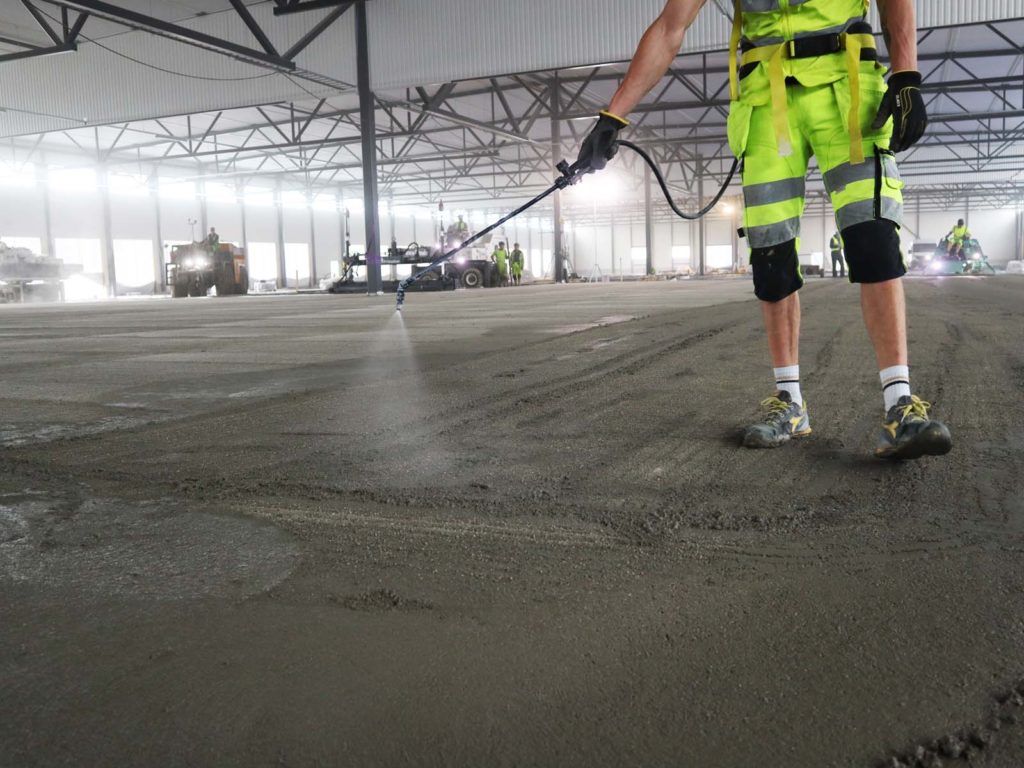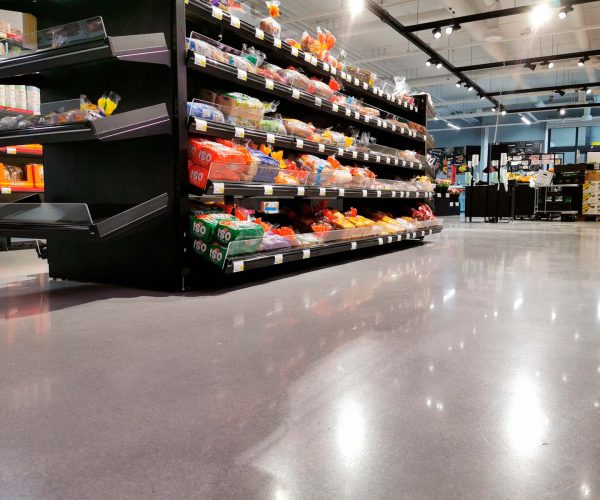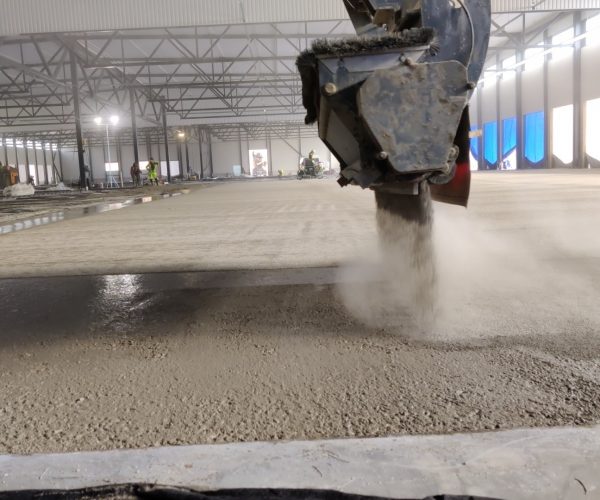Do you know what the BIGGEST mistake with dry-shake hardeners is?
BIGGEST mistake with dry-shake hardeners
Dry-shake surface hardener is a cementitious product containing hard aggregates (quartz, metal, or corundum), admixtures, pigments, and some brands, also polypropylene fibers. A dry-shake is sprinkled evenly over a fresh concrete floor while it is plastic, and when the dry-shake is power-troweled, it bonds monolithically to the base concrete. The ability of a dry-shake material to provide a hard, abrasion-resistant wearing surface depends on how many kilograms of dry-shake contractors can apply and how well the dry-shake will hydrate.
In a perfect world, a contractor can apply a thick enough layer of dry-shake hardener on the concrete surface. A minimum of 5.5 kg/m2 is recommended to apply in two layers to achieve high surface abrasion resistance.
Following dosages of dry shake hardener are recommended by most of the manufacturers:
- Light-duty 3.5–4.0 kg/m2
- Medium-duty 4.5–5.0 kg/m2
- Heavy-duty 5.5-7.0 kg/m2
The sad reality is that many times contractors can only apply ~3 kg/m2, which will give only a 1 mm thick layer of dry-shake, or in most cases, there is NO layer at all because 3 kg will be mixed up with base concrete. The problem worsens if contractors use water while finishing the surface with power trowels. Adding water changes the w/c ratio on the surface, making it much softer.
You get a soft concrete surface when you apply only 3 kg/m2 dry-shake hardener and finish it with water. Even though abrasion resistance should increase with a dry-shake, in these cases that does not happen. Dusting, uneven color/surface, and plastic shrinkage often occur.

Solution:
Always apply dry-shake hardeners according to recommendation of the manufacturers (typically minimum 5.5 kg) in two layers and avoid using water during the finishing process if you want to create a hard, durable, and dust-free surface for your industrial floor. A correctly applied dry-shake will double the concrete surface abrasion resistance (also concrete with liquid hardeners).
Patented Concria Optimal Slab™ solution enables contractors to apply enough dry-shake hardeners. Concria™ Trowel Hard nanotechnology liquid works as an evaporate retarder giving more time for finishers even in challenging weather conditions (high heat, direct sun, wind). Spray Concria Trowel Hard during the finishing, and it lubricates dry-shake hardener better than water and makes the surface stronger and denser.
All Concria™ dry-shake hardeners contain polypropylene fibers that provide better bonding and eliminate/minimize plastic shrinkage when combined with Concria™ Trowel Hard.
READ MORE ABOUT OUR SOLUTIONS
BIGGEST mistake with dry-shake hardeners

Dry-shake surface hardener is a cementitious product containing hard aggregates (quartz, metal, or corundum), admixtures, pigments, and some brands, also polypropylene fibers. A dry-shake is sprinkled evenly over a fresh concrete floor while it is plastic, and when the dry-shake is power-troweled, it bonds monolithically to the base concrete. The ability of a dry-shake material to provide a hard, abrasion-resistant wearing surface depends on how many kilograms of dry-shake contractors can apply and how well the dry-shake will hydrate.
In a perfect world, a contractor can apply a thick enough layer of dry-shake hardener on the concrete surface. A minimum of 5.5 kg/m2 is recommended to apply in two layers to achieve high surface abrasion resistance.
Following dosages of dry shake hardener are recommended by most of the manufacturers:
- Light-duty 3.5–4.0 kg/m2
- Medium-duty 4.5–5.0 kg/m2
- Heavy-duty 5.5-7.0 kg/m2
The sad reality is that many times contractors can only apply ~3 kg/m2, which will give only a 1 mm thick layer of dry-shake, or in most cases, there is NO layer at all because 3 kg will be mixed up with base concrete. The problem worsens if contractors use water while finishing the surface with power trowels. Adding water changes the w/c ratio on the surface, making it much softer.
You get a soft concrete surface when you apply only 3 kg/m2 dry-shake hardener and finish it with water. Even though abrasion resistance should increase with a dry-shake, in these cases that does not happen. Dusting, uneven color/surface, and plastic shrinkage often occur.
Solution:
Always apply dry-shake hardeners according to recommendation of the manufacturers (typically minimum 5.5 kg) in two layers and avoid using water during the finishing process if you want to create a hard, durable, and dust-free surface for your industrial floor. A correctly applied dry-shake will double the concrete surface abrasion resistance (also concrete with liquid hardeners).

Patented Concria Optimal Slab™ solution enables contractors to apply enough dry-shake hardeners. Concria™ Trowel Hard nanotechnology liquid works as an evaporate retarder giving more time for finishers even in challenging weather conditions (high heat, direct sun, wind). Spray Concria Trowel Hard during the finishing, and it lubricates dry-shake hardener better than water and makes the surface stronger and denser.
All Concria™ dry-shake hardeners contain polypropylene fibers that provide better bonding and eliminate/minimize plastic shrinkage when combined with Concria™ Trowel Hard.



